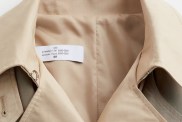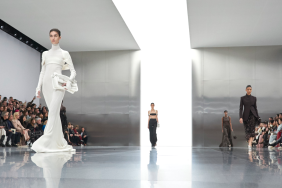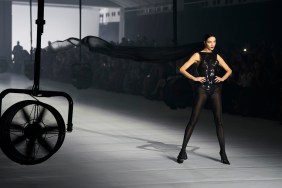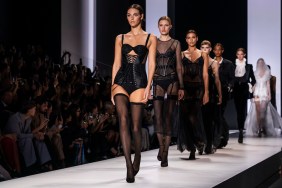
Francis Bitonti
Francis Bitonti wants to blur the lines between fashion and technology with his trademarked design process that merges computer technology and 3D printing. Using his unique approach, Bitonti has been able to create fully functional, one-of-a-kind gowns and fashion accessories and his work has been featured internationally in prestigious institutions, including the Cooper Hewitt, Smithsonian Design Museum. Most recently, he printed a gown that was worn by Dita Von Teese. We caught up with the New York based designer to find out more about his out-of-the-box process.
theFashionSpot: Can you tell us a little bit about your background? How did you get your start in fashion?
Francis Bitonti: I had a very unique background. I started out wanting to be a writer then transitioned into visual arts then into computer graphics. I was interested in everything and explored all I could and it led me to synthesize my own discipline and my own voice. There are not many people who work the way that I do and have the perspective that I do. I approach materials by thinking about them through digital media. I think about physical things more like a filmmaker than a designer; it’s about how they unfold in time. It’s more about pixels than plastics or fabrics. This led me to 3D printing. I needed a link to the physical through the digital. It’s the way my mind works because of my unique background. I later went to school for architecture and worked as an architect for a bit, but I realized I was interested in other things and it would be better to start my journey with product design. This was difficult, 3D printing was still very expensive and people didn’t see much potential beyond prototyping. Eventually, I found my way into some collaborations with fashion designers, and it worked well. I found that our interests were very much aligned and the technology I was working with had immediate value for them. It allowed them to produce complex ornamental forms faster and with less investment than working with traditional craftsmen.
tFS: What was the hardest part about transitioning from architecture?
FB: Nothing was too difficult about it. I always considered myself a designer; a designer doesn’t need to worry about what discipline they work in. You see the world in your own particular way. You have a certain view of people and the way the world works; a designer puts physical things into the world that manipulates flows of materials and commerce. I never had to transition into anything, if it’s a dress or a building, I hope to do both in my life. I use matter to structure people’s lives. The things we make are the fingerprint of culture, and designers make culture. They manifest all our hopes, fears and ambitions as society in physical goods. It’s a job I take very seriously, it’s a job done best if we think expansively across all aspects of life.

tFS: What exactly does it mean to print wearable fashion?
FB: We are trying to revolutionize manufacturing. What we are calling couture now is going to be the ready-to-wear of tomorrow. My work defines a future without extra charges for complexity or customization. We are creating material properties and effects that were once only the stuff of science fiction movies. We are moving manufacturing to the cloud. We are taking the last part of our culture that has not been decentralized and decentralizing it. It’s been great how the fashion industry took up social media. I am now offering a definition of materiality that can be formed in the cloud. Materials now can be formed in digital environments by social media. It’s about brands no longer having customers, but users. Brands need to think like [the] software business now. It’s about creating new co-creation experiences. People don’t want to be given a lifestyle, they want to participate. It’s about consumption becoming production.
tFS: Where did the idea for this come about? What was the process to master this technique?
FB: I always tell students the most important thing they can do in life is be sincere. If you follow every desire and everything you are interested in you will create something that is as unique as you. There was no idea to come up with and no technique to master — my career is a product of being me. Something everyone knows how to do if they let themselves.

tFS: What’s the pricing like for your pieces? Are they all one-of-a-kind?
FB: Right now they are all one-of-a-kind, but this is not our goal. It’s hard to put a price on something that is completely customized. However, eventually we want to bring this technology to everyone. This is going to be the way everything is made — we are working very hard to make sure that happens. I realize this is something that is going to take a long time, we are reinventing the industry and we are focused on mass production. For now, couture pieces are what I am making, so it’s hard to give a general price point, but eventually I’d like to make it available to everyone.
tFS: From techniques to social media, how do you think technology is changing fashion?
FB: This is one of the biggest issues with the fashion industry right now. It’s not about any of those things. Look at what the Internet did to digital media, movies, books and music. These creative industries had to find new business models because new emerging infrastructures for distribution and production made it difficult to be competitive in the marketplace with traditional business models. The fashion industry needs to be anticipating this change. If I get my way, everything in the world will be digitized one day. Tech, if you’re smart about it, is about building platforms, infrastructures and communities that are larger than any one person. Designers need to be thinking about infrastructures for production and distribution or else they will be left by the wayside. We think through algorithms because they are flexible, adaptable and intelligent. Our brand, when we are done building it, will be an artificial intelligence people will cooperate with in daily life. Consumers don’t want to passively consume anymore: They want to participate. That’s the biggest change technology is bringing the industry.
tFS: Are you active in social media? How have you gone about getting people to know about your brand?
FB: Yes, we use social media…the fashion industry has been great at adopting this technology. But there is much more to our tech-abilities than this. We design through algorithm. It’s all been very organic. The work we are doing is unique, so I feel that I don’t need to clamor for attention. We are doing things only a few people in the world can do, and we are changing the industry in a very deep way. It’s never been hard to get people to notice the work and if they don’t get it now, they will soon not be able to ignore it. If what you are doing has value, people will listen.

tFS: What are some of the biggest day-to-day challenges of running a fashion business?
FB: The biggest challenge for me right now is staffing. We need people with such a unique skill set. Where can you find a computer programmer with a sense of style? The two don’t need to be mutually exclusive; I wish fashion schools would integrate computing into the curriculum.







